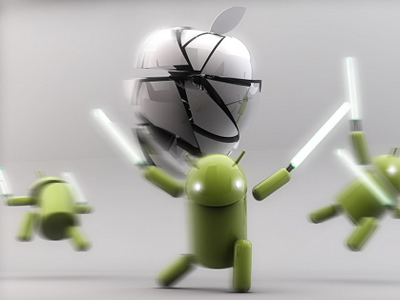Backing up claims made by Google, during 2012's fourth-quarter, Android continued its global market dominance, while iOS remained the market leader in the United States.
In the 12 weeks ending on December 23, Google's Android platform accounted for over half of all smartphone sales. In Spain, it accounted for 87 percent of all smartphone sales, while in China 72 percent of smartphone sales were Android devices.
During the 12 weeks ending on December 23, iOS accounted for 44.9 percent of the market in the U.S., while Android followed in a close second with 44.8 percent. However, due to record activations on Christmas day, the 12 weeks ending on December 25 saw Apple's platform accounting for 51.2 percent, with Android settling for 44.2 percent.
"At the end of 2012 the global OS picture shows Android on top, but clearly the rate of growth it experienced over the past year is beginning to slow as easy wins from first time smartphone buyers begin to reduce," said Dominic Sunnebo, global consumer insight director at Kantar Worldpanel ComTech. "It has been far slower than Microsoft would have liked, but Windows Phone is now starting to gain respectable shares in a number of key European countries. However, its performance in the Chinese and US markets remains underwhelming. As the two largest smartphone markets in the world, these remain key challenges for Microsoft to overcome during 2013."
“Among the handset manufacturers, Samsung has held onto the number one spot in Britain, claiming 35% of smartphone sales, although Apple is now biting at its heels with 32%. Nokia is experiencing something of a turnaround in Britain with its smartphone sales share at 6.2% and actual sales growing by over 50% compared with last year. Meanwhile, BlackBerry continues to find trading tough in the run up to the BlackBerry 10 release; however, its 9320 handset gave it a boost over Christmas with two-thirds bought as a gifts."
Smartphones proved to be popular over the holiday season during Q4 with a third of all handsets purchased in December given as Christmas gifts. "The BlackBerry 9320 was the most popular gifted handset in December, followed by the Samsung Galaxy Ace 2 and Apple iPhone 4S. The majority of smartphone gift recipients were under 18 years old and 57% were women. More than one in five handsets bought as gifts in Britain during December were from Tesco."
Contact Us for News Tips, Corrections and Feedback
Get Tom's Hardware's best news and in-depth reviews, straight to your inbox.

Zak Islam is a freelance writer focusing on security, networking, and general computing. His work also appears at Digital Trends and Tom's Guide.
-
JOSHSKORN All I have to say is, Jelly Bean is awesome. ICS kinda sucked (the life out of my battery). DROID RAZR MAXX user here. Even though what I have was an accidental JB update.Reply -
bombebomb ICS= this is a fairly nice OS, nice job google, jellybean = holy awesome batman where did this come from.Reply -
teh_chem Jesus dude, stop reporting phone activations as market share, and for the love of god please stop referring back to that terribad report that iOS claims more than 50% of phone market share. It does not. New phone activations are not and will never be a representation of market share.Reply
And lastly, Kantar Worldpanel does not at all track market share. They're a consumer-study group, and only look at device sales. No amount of examining device sales will tell you if someone abandoned their old iOS device for a new iOS device (android, windows phone, whatever), so it says nothing about market share and the overall total number of actual ongoing users of the platform. -
mydrrin teh_chemJesus dude, stop reporting phone activations as market share, and for the love of god please stop referring back to that terribad report that iOS claims more than 50% of phone market share. It does not. New phone activations are not and will never be a representation of market share.And lastly, Kantar Worldpanel does not at all track market share. They're a consumer-study group, and only look at device sales. No amount of examining device sales will tell you if someone abandoned their old iOS device for a new iOS device (android, windows phone, whatever), so it says nothing about market share and the overall total number of actual ongoing users of the platform.Reply
Listen dumbass, activations is a metic none same. The number of activations means the number of phones that are put into the pool, and shows how healthy companies are. Nokia still has good marketshare right? 'Nuff said. -
davewolfgang Hey Dumbass Mydrrin - New phone activations only tell us...I know, get this... NEW PHONE ACTIVATIONS!!!Reply
New phone activations =/= market share.
I've had my phone for three years - but MY market share isn't with iOS - so since I'm NOT on that new activation "report" - I don't count? I'm sure GooglePlay counts me since I HAVE purchased apps in that three years.
So again - new phone activations DO NOT EQUAL market share. Because NOT EVERYONE get a new phone in whatever time period they are using. -
DjEaZy ... in other news...Reply
http://www.tomsguide.com/us/Android-Botnet-Trojan-China-Google,news-16613.html -
JOSHSKORNAll I have to say is, Jelly Bean is awesome. ICS kinda sucked (the life out of my battery). DROID RAZR MAXX user here. Even though what I have was an accidental JB update.Reply
I agree with this (ASUS TF700 user here) even though the two are not all that dissimilar, there is just something about jellybean, it seems more refined and smoother -
dthx So again - new phone activations DO NOT EQUAL market share. Because NOT EVERYONE get a new phone in whatever time period they are using.Sorry, but you are confusing two things here... Market Share and MIFReply
Wether you are a PC's, printers or bikes manufacturer, your market share is always the volume of your sales compared to the total sales volume of the market, for a given period (a quarter, a month,...) and region. You may expect as well that the new activation figures are close to the sales figures as not many people buy an expensive smartphone not to use it...
You would apparently like to see market shares calculated in terms of MIF (Machines in Field). The MIF is a estimation of the amount of devices truly in use at a given time. The MIF can be a very interesting figure for a company that manufactures consumables or provides repair services... as it gives a good idea of the quantity of customers you can reach by providing a product for a certain device, but in terms of sales strategy, the MIF gives you very little clue about the future of a product. Market shares, based on recent sales or activation volumes are much more relevant for your sales strategy.
